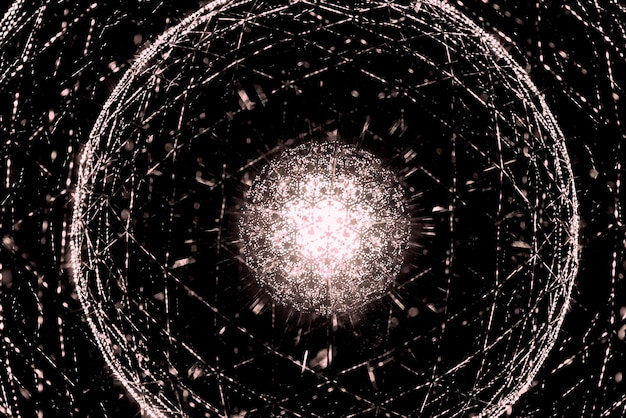Exploring Synchronicity: Find Meaning in Coincidences

Exploring the concept of synchronicity involves recognizing meaningful coincidences that appear in your life, understanding them not as random events, but as potential messages from the universe guiding your path.
Have you ever thought about why certain coincidences happen in your life? Exploring the concept of synchronicity offers a fascinating lens through which to view these occurrences, transforming seemingly random events into meaningful signposts.
Understanding Synchronicity: More Than Just Coincidence
Synchronicity is a term coined by Carl Jung to describe the occurrence of meaningful coincidences that seem to be related but have no apparent causal connection. These aren’t just any coincidences; they resonate with deep personal significance.
At its core, synchronicity suggests a hidden order underlying our experiences, a way in which the universe communicates with us through symbolic events. Recognizing and understanding synchronicity in your life can open doors to new perspectives and a deeper understanding of yourself.
The Core Components of Synchronicity
Synchronicity isn’t merely about coincidences piling up; it’s about the quality and impact of those coincidences. It hinges on a few key elements that differentiate it from random chance.
- Meaningfulness: The coincidences must hold personal significance.
- Acausality: There should be no apparent causal link between the events.
- Emotional Impact: Synchronistic events often evoke a strong emotional or intuitive response.
When these components align, a simple coincidence transforms into a powerful synchronistic experience, prompting deeper reflection and understanding. This process can lead to personal growth and a sense of connection to something larger than oneself.
Ultimately, the perception of synchronicity is subjective, deeply personal, and rooted in one’s individual experiences and beliefs. It’s about recognizing the patterns and messages that resonate within your own life’s narrative.

The History and Psychology of Synchronicity
Carl Jung, a Swiss psychiatrist and psychoanalyst, significantly shaped the understanding of synchronicity. His collaboration with physicist Wolfgang Pauli further explored its implications bridging psychology and quantum physics.
Jung initially encountered the concept while treating patients, observing recurring themes and symbols that seemed to defy causality. This led him to develop the theory of synchronicity, positioning it as an essential element in understanding the human psyche.
Synchronicity and the Collective Unconscious
Jung believed that synchronicity reflects the interplay between the individual’s conscious and unconscious mind, and the collective unconscious, a shared reservoir of archetypes and universal symbols.
Synchronistic events, in Jung’s view, act as a bridge between these realms, bringing unconscious content to conscious awareness. This process can facilitate individuation, the psychological process of integrating all aspects of the self.
The Psychological Impact of Synchronicity
Experiencing synchronicity can have a profound effect on an individual’s psychological well-being. It can foster a sense of connection to the universe, reduce feelings of isolation, and increase self-awareness. These effects can be both immediate and long-lasting, shaping one’s approach to life and its challenges.
- Enhanced Self-Awareness: Synchronicity often prompts introspection, leading to deeper self-understanding.
- Increased Sense of Meaning: Recognizing meaningful coincidences can infuse life with purpose and direction.
- Emotional Resilience: Experiencing synchronicity can promote a sense of hope and optimism during difficult times.
For many, recognizing synchronicity becomes a practice—a way of paying closer attention to the subtle cues and patterns that life presents. By doing so, individuals may cultivate a richer, more meaningful existence.
In essence, understanding the history and psychology of synchronicity can provide valuable insights into the nature of consciousness, meaning, and the interconnectedness of all things.
Identifying Synchronicities in Everyday Life
Being able to discern synchronicity from mere coincidence starts with cultivating a heightened awareness of your surroundings and inner thoughts. It involves paying close attention to the subtle nuances and patterns that life presents.
It’s about tuning into your intuition and recognizing the emotional resonance associated with particular events. This awareness is vital in recognizing potential synchronicities that might otherwise go unnoticed.
Practical Steps for Noticing Synchronicities
There are several practical steps you can take to enhance your ability to identify synchronicities in your daily experiences.
Start by keeping a journal where you record any unusual coincidences, dreams, or insights that stand out. Note the date, time, and circumstances surrounding each event, as well as your emotional response. Reviewing these entries periodically can reveal recurring themes and patterns.
- Practice Mindfulness: Cultivate a present-moment awareness to better observe and appreciate coincidences.
- Trust Your Intuition: Pay attention to your gut feelings and hunches, as they often accompany synchronicities.
- Be Open to the Unexpected: Allow for spontaneity and be willing to deviate from your usual routine.
Engaging in creative activities, such as writing, painting, or playing music, can also help open your mind to new perspectives and synchronicities. These activities can serve as conduits for unconscious content to emerge into conscious awareness.
Ultimately, recognizing synchronicity is a skill that develops over time with practice and intention. The more attuned you become to the subtle cues of your environment and your inner world, the more readily you will perceive the meaningful coincidences that enrich your life.

Interpreting the Meaning Behind Synchronistic Events
The interpretation of synchronistic events is deeply personal and subjective, reflecting your unique experiences, beliefs, and values. What one person considers a significant synchronicity, another may dismiss as a random occurrence.
Finding meaning in synchronicities requires introspection, openness, and a willingness to explore the symbolic language of the unconscious. It’s about uncovering the messages that these coincidences may be conveying.
Guidelines for Interpreting Synchronicities
While there is no standardized method for interpreting synchronicities, there are several guidelines that can help you navigate this process. Start by examining the circumstances surrounding the event and identifying any personal associations or connections.
Consider the emotions and thoughts that arose during and after the experience. These can provide valuable clues about the underlying meaning. Pay attention to recurring symbols, patterns, or numbers, as these often hold symbolic significance.
Common Pitfalls to Avoid
It’s essential to approach the interpretation of synchronicities with discernment and avoid common pitfalls that can lead to inaccurate or misleading conclusions.
- Over-Interpretation: Avoid assigning excessive or far-fetched meanings to coincidences; keep interpretations grounded in reality.
- Confirmation Bias: Be wary of cherry-picking evidence to support pre-existing beliefs or expectations.
- Superstitious Thinking: Distinguish between genuine synchronicities and superstitious associations based on fear or wishful thinking.
Remember, the purpose of interpreting synchronicities is to gain insights and understanding, not to reinforce biases or create unnecessary anxiety. Approach each event with curiosity and an open mind.
Ultimately, the meaning you derive from synchronistic events is a reflection of your inner world and your unique journey through life. Trust your intuition and allow the process unfold naturally.
Synchronicity vs. Serendipity: Understanding the Difference
While synchronicity and serendipity are often used interchangeably, they represent distinct concepts with subtle but significant differences. Understanding these nuances can provide a clearer framework for interpreting life’s unexpected turns.
Serendipity refers to fortunate accidents or pleasant surprises that occur seemingly by chance. It typically involves stumbling upon something valuable or beneficial while not actively seeking it.
Key Differences Between Synchronicity and Serendipity
The key distinction between synchronicity and serendipity lies in the presence of personal meaning and acausality. Synchronicity involves meaningful coincidences that have no apparent causal connection, whereas serendipity may or may not have personal significance.
Serendipitous events often lead to positive outcomes in a straightforward, causal manner. Discovering a winning lottery ticket on the street is an example of serendipity; it’s a fortunate accident that directly leads to a financial windfall.
- Meaning vs. Fortune: Synchronicity centers on personal meaning, while serendipity focuses on fortunate outcomes.
- Acausality vs. Causality: Synchronicity defies traditional causality, whereas serendipity typically occurs within a causal framework.
- Subjective Experience: Synchronicity is highly subjective, whereas serendipity can be more objective in its impact.
Synchronicity, on the other hand, involves coincidences that seem to be connected at a deeper level. It’s seeing the same obscure symbol repeatedly in different contexts and sensing that it’s a message specifically for you.
Both synchronicity and serendipity can enrich our lives by opening doors to new opportunities and insights. However, the former invites us to delve into the depths of our psyche, while the latter encourages us to appreciate the surprises along the way.
By distinguishing between synchronicity and serendipity, we can better appreciate the diverse ways in which life’s unexpected events contribute to our personal growth and understanding.
Harnessing Synchronicity for Personal Growth
Once you begin to recognize and interpret synchronicities in your life, you can harness them as a powerful tool for personal growth and self-discovery. By paying attention to these meaningful coincidences, you gain access to a deeper understanding of yourself and your life’s purpose.
Synchronicity can serve as a compass, guiding you towards new opportunities, relationships, and experiences that align with your authentic self. It’s about aligning your actions with the messages and patterns you observe in the world around you.
Practical Applications of Synchronicity for Growth
There are several practical ways to harness synchronicity for personal growth and self-discovery. Start by setting clear intentions and goals, and then watch for synchronicities that support or challenge these intentions.
Use these synchronicities as opportunities for introspection and reflection, asking yourself what they might be telling you about your path. Be open to adjusting your course if the synchronicities suggest a different direction.
- Track recurring themes: Note repeating symbols, numbers, or people appearing in unexpected places.
- Reflect on emotional responses: Analyze what feelings arise during synchronistic moments.
- Take inspired action: If a synchronicity prompts an idea, explore it further.
Engage in practices that enhance your intuition and mindfulness, such as meditation, yoga, or spending time in nature. These activities can help you become more attuned to the subtle cues and patterns of synchronicity.
Surrounding yourself with supportive and like-minded individuals can also create a fertile ground for synchronistic events. Sharing your experiences and insights with others can amplify their impact and lead to new discoveries.
Ultimately, harnessing synchronicity for personal growth is about cultivating a mindful and intentional approach to life, allowing the meaningful coincidences you experience to guide you towards your highest potential.
| Key Point | Brief Description |
|---|---|
| 💡 Identifying Synchronicities | Cultivating awareness to recognize meaningful coincidences. |
| 🤔 Interpreting Meaning | Reflecting on personal significance to gain insights. |
| ✨ Personal Growth | Using synchronicities as guidance for self-discovery. |
| ☯️ Synchronicity vs. Serendipity | Distinguishing between meaningful connections and fortunate accidents. |
Frequently Asked Questions about Synchronicity
Synchronicity refers to meaningful coincidences that seem related but have no apparent cause. It is when an internal thought or feeling aligns with an external event in a significant, non-causal way.
While coincidence is simply two events happening at the same time, synchronicity has a personal meaning or significance. Synchronistic events often feel like more than just a random occurrence – they resonate.
Yes, anyone can experience synchronicity. However, it often requires an open mind, heightened awareness, and a willingness to look for patterns in life. Mindfulness can help to increase synchronicities.
Currently, there isn’t a widely accepted scientific explanation. Carl Jung proposed it as an acausal connecting principle. Some theories suggest connections to quantum physics and the observer effect.
Synchronicities can offer guidance, validation, and encouragement along your life path. By paying attention to these meaningful events, you may gain insights into your purpose, decisions, and relationships.
Conclusion
Exploring the concept of synchronicity opens us to a richer, more meaningful understanding of the events in our lives. By recognizing and interpreting these meaningful coincidences, we can unlock valuable insights, foster personal growth, and deepen our connection to the universe.





